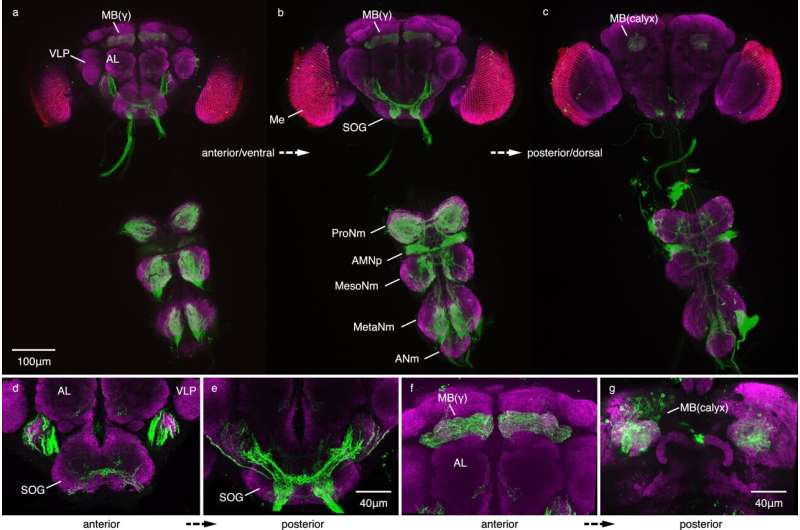This article has been reviewed according to Science X's editorial process and policies. Editors have highlighted the following attributes while ensuring the content's credibility:
fact-checked
peer-reviewed publication
trusted source
proofread
Researchers identify 'degrees of Kevin Bacon' gene in well-connected fruit flies

A team of researchers from the University of Toronto has identified a gene in fruit flies that regulates the types of connections between flies within their "social network."
The researchers named the gene "degrees of Kevin Bacon" (dokb) for the prolific star of such films as Footloose and Apollo 13. The parlor game, Six Degrees of Kevin Bacon, in which a random actor's connection to Bacon is traced through a chain of co-stars, reflects the actor's numerous connections to other actors.
It is common for animals to exist in social groups or networks—for example, a pride of lions or a pod of dolphins—within which exist a multitude of interactions and relationships. Within these networks, individuals and groups have different levels of connectedness.
The researchers studied groups of two distinct strains of Drosophila melanogaster fruit flies and found that one strain showed different types or patterns of connections within their networks than the other strain.
The researchers then isolated the dokb gene in the first strain, also known as CG14109, associated with that connectivity. When they swapped the gene from one strain to another, the recipients exhibited the connectivity of the other strain.
"There's been a lot of research around whether social network structure is inherited but that question has been poorly understood," says Rebecca Rooke, who carried out the work as part of her Ph.D. thesis at U of T Mississauga.
Rooke is the lead author of the paper describing the research, titled "The gene 'degrees of kevin bacon' (dokb) regulates a social network" and published in Nature Communications.
It has been thought that rather than inheriting the ability, animals instead learn how to interact with other individuals. "But what we've now done is find the gene and proven there is a genetic component," she says.
Rooke is a postdoctoral fellow in Professor Joel Levine's laboratory, which was located at UTM when this research took place.
"This gives us a genetic perspective on the structure of a social group," says Levine, who is currently chair of the department of ecology & evolutionary biology in the Faculty of Arts & Science.
"This is amazing because it says something important about the structure of social interactions in general and about the species-specific structure of social networks. It's exciting to be thinking about the relationship between genetics and the group in this way. It may be the first time we've been able to do this."
The researchers measured the type of connection by observing groups of a dozen male flies placed in a container and video recorded.
Using software previously developed by Levine and post-doctoral researcher Jon Schneider, the team tracked the distance between flies, their relative orientation and the time they spent in close proximity. Using these criteria as measures of interaction, the researchers calculated the type of connection or "betweenness centrality" of each group.
Rooke, Levine and their colleagues point out that individual organisms with high betweenness centrality within a social network can act as "gatekeepers" who play an important role in facilitating interactions within their group.
Gatekeepers can influence factors like the distribution of food or the spread of disease. They also play a role in maintaining cohesion, enhancing communication and ensuring better overall health of their group.
In humans, betweenness centrality can even affect the spread of behaviors such as smoking, drug use and divorce.
At the same time, the researchers point out that social networks are unbiased and favor neither "good" nor "bad" outcomes. For example, high betweenness centrality in a network of scientists can increase potential collaborators; on the other hand, high betweenness centrality in another group can lead to the spread of a disease like COVID-19.
"You don't get a good or a bad outcome from the structure of a network," explains Levine. "The structure of a network could carry happiness or a disease."
Rooke and Levine are both excited about the research this discovery opens up.
"I think the most interesting next step is to identify the overall molecular pathway this gene and its protein are involved in," says Rooke. "To try to understand what the protein is doing and what pathways it's involved in. The answers to those questions will really give us a lot of insight into how these networks work."
And while the dokb gene has only been found in flies so far, Rooke, Levine and their colleagues anticipate that similar molecular pathways between genes and social networks will be found in other species.
"For example, there's a subset of cells in the human brain whose function relates to social experience—what in the popular press might be called the 'social brain,'" says Levine.
"Getting from the fly to the human brain—that's another line of research. But it almost has to be true that the things that we're observing in insects will be found in a more nuanced, more dispersed way in the mammalian brain."
More information: Rebecca Rooke et al, The gene "degrees of kevin bacon" (dokb) regulates a social network behaviour in Drosophila melanogaster, Nature Communications (2024). DOI: 10.1038/s41467-024-47499-8




















